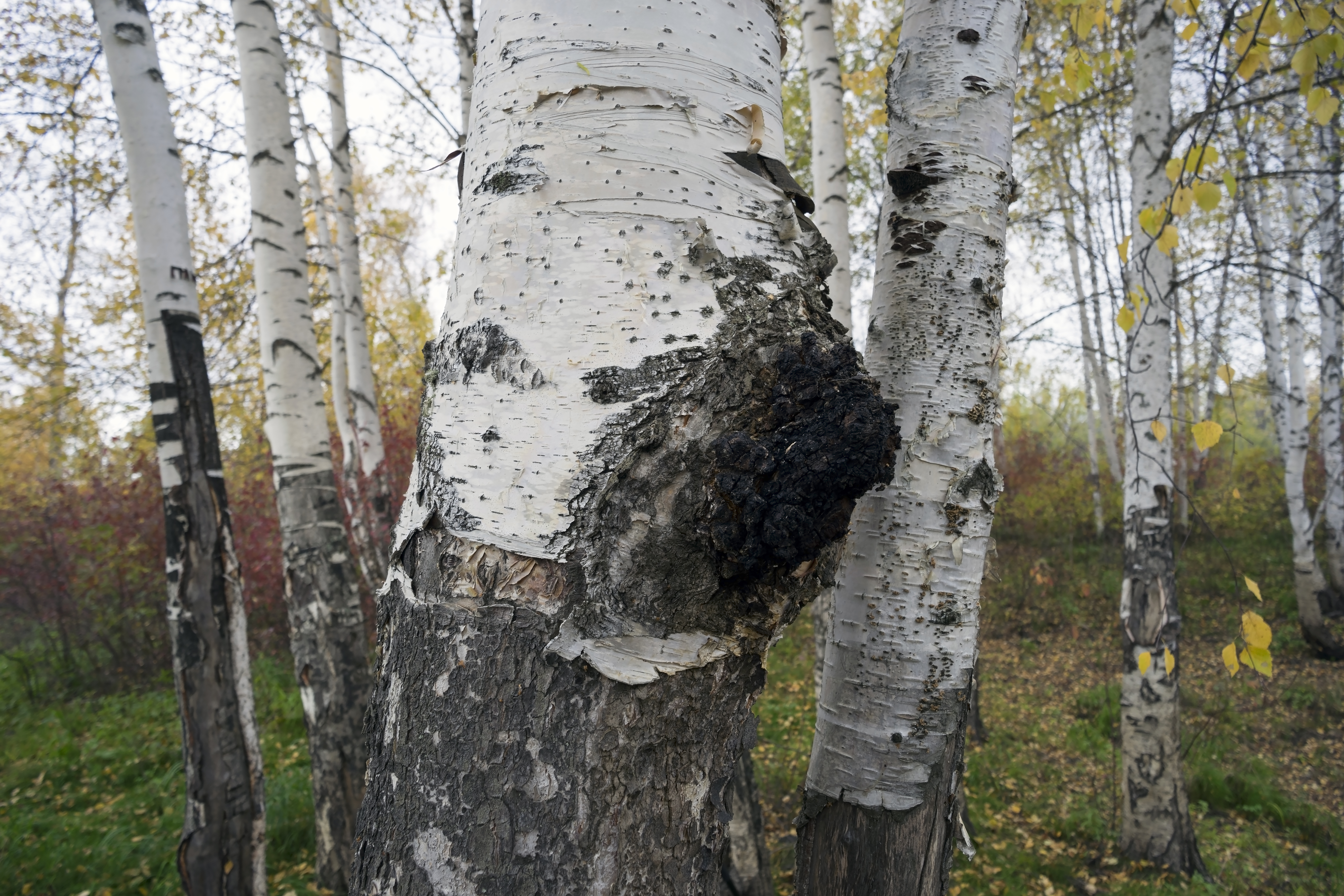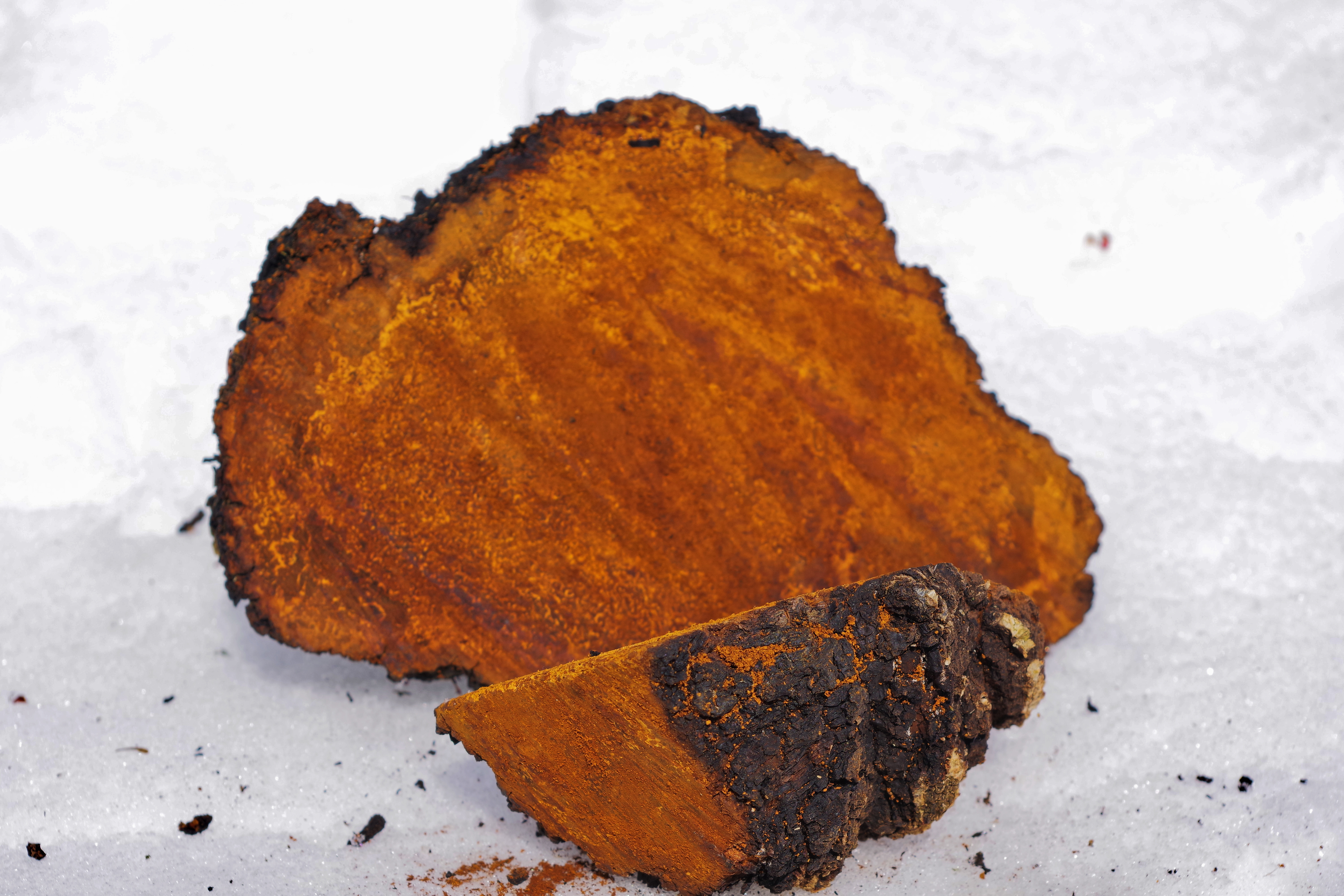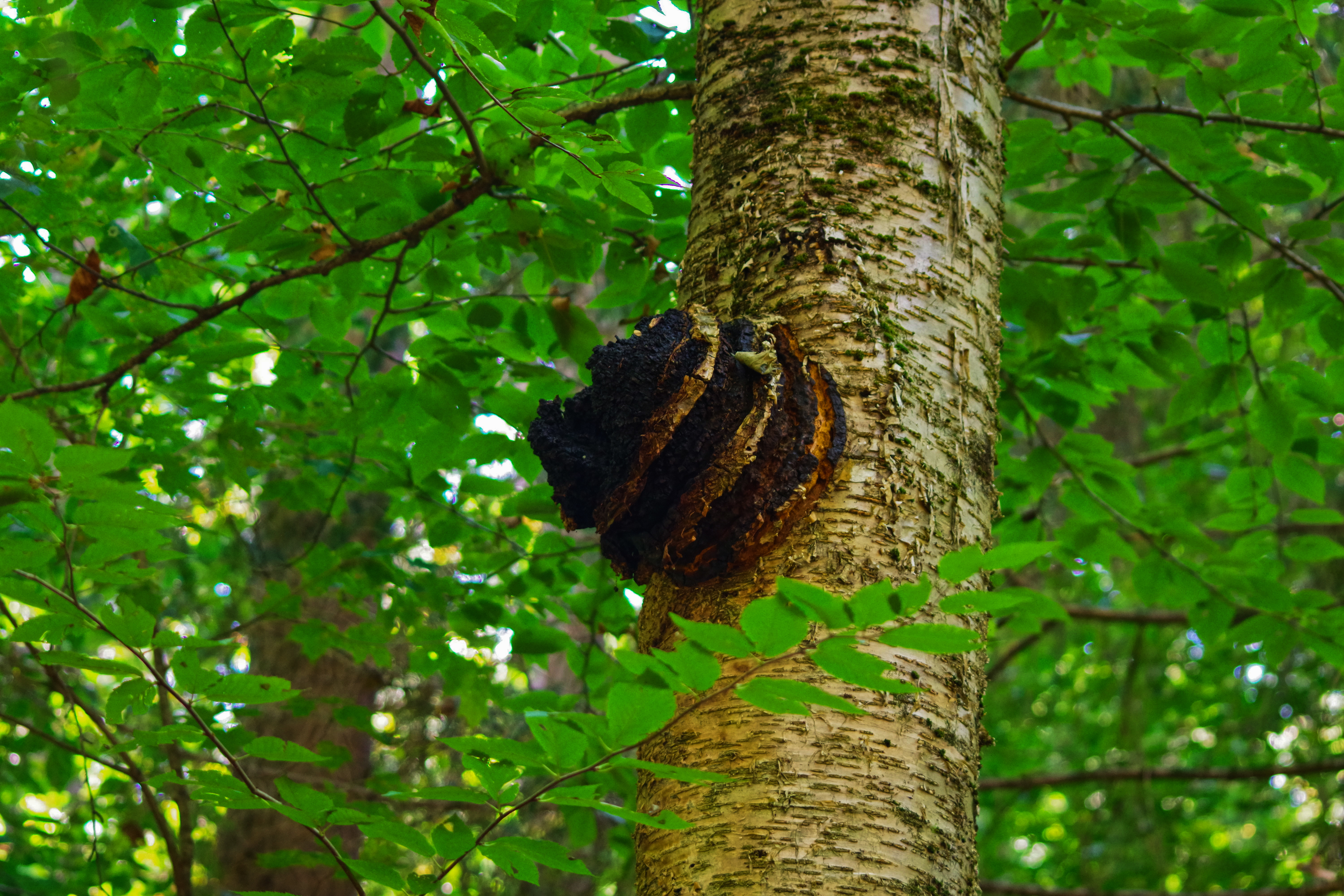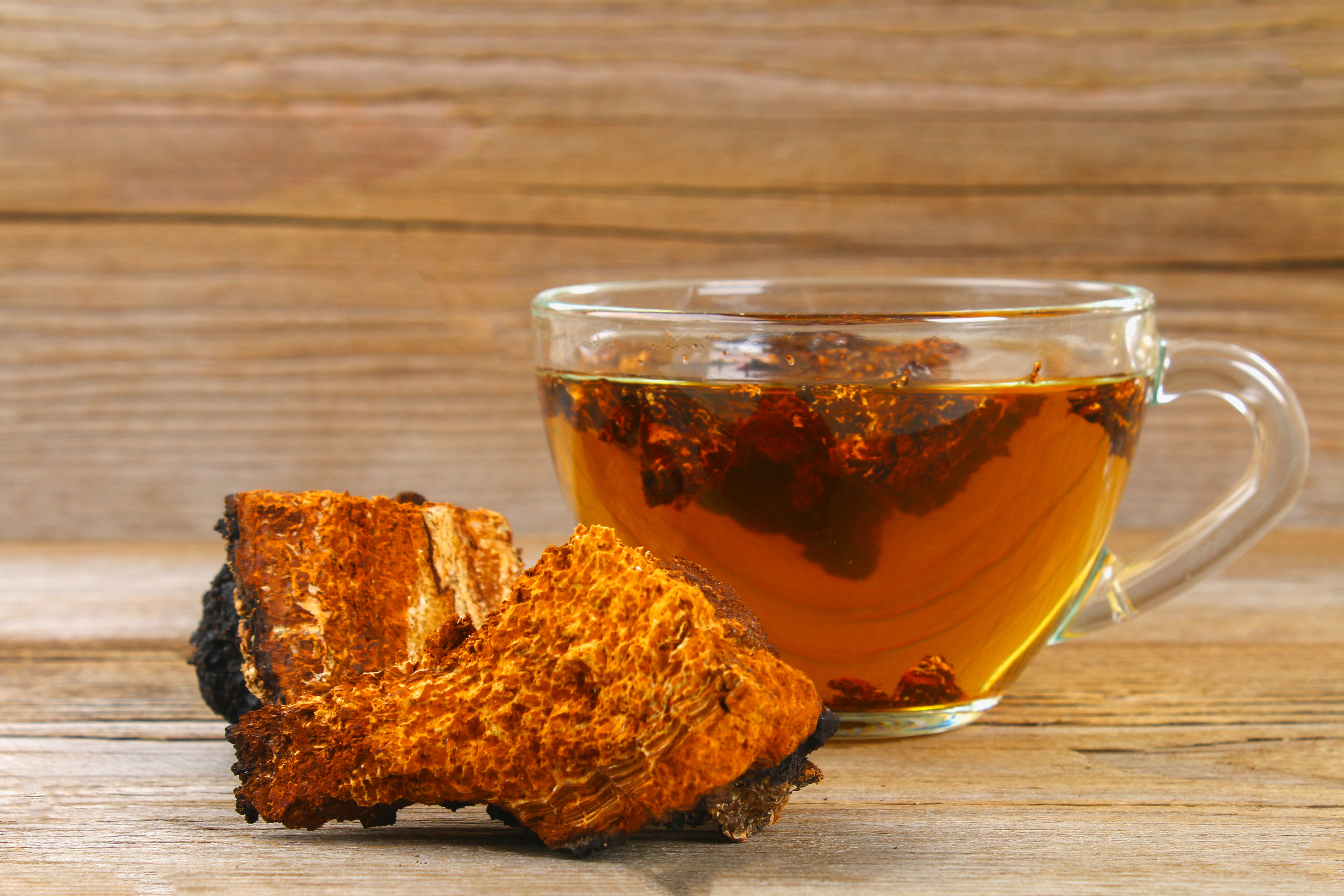We continue our exploration into medicinal mushrooms with another heavy hitter and one you may not have heard of: chaga mushroom! Like the reishi, this mushroom doesn’t taste amazing, but there are many benefits to it that make it a great addition to your protocol. Today, we go into the history and uses of chaga and what makes it a potent cancer-fighting fungus. Let’s get started!
*Note: Please keep in mind that I am not a doctor and you should not take the following information as a replacement for advice from a licenced professional. Always consult with a member of your healthcare team before starting any new supplements or natural compounds.

A chaga growth on a birch
Checking Out Chaga
Unlike many mushrooms who have their roots (or spores 😉) in Asia, chaga was historically first used by the Khanty people of Western Siberia, although it did eventually make its way into Chinese medicine [1].
Chaga looks nothing like what we imagine the typical mushroom to be. They grow on birch trees and are classified as having a parasitic relationship to their host trees, ultimately causing their decomposition and death. The look like large, rough, brown blobs that protrude from a crack in the tree through which the spores initially got in. Inside, however, they are a beautiful, bright orange colour and have a consistency something like cork [1].
Like the turkey tail mushroom, these guys are abundant, growing all over the northern hemisphere, from east to west. They can be found wherever birch trees are prevalent, in the northern parts of the lower 48 states, Canada, Alaska, Russia and Asia [1]. If you live in one of these areas, you very likely have seen a chaga while on a hike. Keep your eyes peeled the next time you are out in the forest!

What’s their deal?
Throughout the development of its use and study, chaga has been used for a wide variety of ailments and is purported to have many medicinal benefits. It has been used to improve digestion, combined into soap to soothe the skin with its anti-inflammatory properties, and to improve immune function [1]. After the Chernobyl disaster, chaga was used to provide relief to those suffering from radiation poisoning [1]. And we can’t forget its anticancer properties, which I will detail below. Most commonly, chaga is cut into pieces and dried to be later brewed into a tea or decoction.

Cancer Crusader
The active compound in chaga that is most studied for its anticancer action is called Inotodiol, a chemical compound comprised of three terpenes (similar to essential oils, terpenes give the plants that produce them their distinctive tastes and smells, often deterring animals from eating them). Like most natural compounds and cancer, well-designed human trials are needed to fully explore and confirm chaga’s benefits for this disease. The research that has been done with animal models, however, is very promising, and chaga remains a viable possibility for cancer treatment that warrants further exploration.
Tumouricidal Effects
Cancer cells are so dangerous and form tumours because they have mutated and no longer listen to the direction to die or to stop replicating. Their cell cycle, therefore, continues on and on, making more and more cells that in turn make cells, and eventually a tumour forms. In a recent study from just this past May, Inotodiol was used against HeLe cells (an immortal cell line derived from cervical cancer cells that is the oldest and most commonly used in cancer research [2]). When the concentrations got to above 25 μM, Inotodiol significantly inhibited cell growth and induced apoptosis (programmed cell death) [3]. And further, a 2010 study found that chaga slowed the growth of lung, breast, and cervical cancer cells [4].
Preventing Metastasis
Chaga has also been proven to act against cancer by reducing the likelihood of metastasis. The same 2019 study found that even a low-concentration dose of chaga significantly reduced cell migration and invasion [3]. There are two enzymes that aid in cancer metastasis. MMP-2 is an enzyme that degrades components of the extracellular environment and causes tumour tissue relaxation, increasing metastasis [5]. The detection of active MMP-2 is considered to be a very sensitive indicator of metastasis and is correlated with shortened survival, particularly in breast cancer. MMP-9 is another enzyme that plays a role in metastasis and is produced mainly by tumour cells themselves, the highest levels being found in triple negative and basal-like tumours. A study from 2014 using breast cancer cells showed that MMP-9 is specifically required for invasion and for pulmonary metastasis (metastasis through blood or lymphatics) [6]. The 2019 study found that in addition to reducing cell migration and invasion, chaga also lowers the levels of both MMP-2 and MMP-9 enzymes [3].
Anti-angiogenic Properties
The MMP-9 enzyme has also been found to play a role in tumour growth by promoting the formation of blood vessels to feed a tumour (angiogenesis) [6]. By decreasing levels of this enzyme, chaga also works to prevent angiogenesis, particularly in triple negative and basal-like tumours where the levels of this enzyme are usually the highest.
Immunomodulating Properties
Cytokines play an important role in our immune function. They are proteins that are secreted by our immune cells and they act like messengers, telling white blood cells in the immune system to turn on and thereby activating an immune response. Some research on mice suggests that chaga can help in the production and balancing of these cytokines, promoting immunity by helping the parts of our immune system to communicate properly [7].
Potent Antioxidant
The level of antioxidants present in chaga mushrooms is unmatched by any other natural food. “It’s 45x higher than acai berries, 80x higher than pomegranates, and 1,300x higher than blueberries.” [1]. Incredible! Antioxidants reduce oxidative stress, damage to our cells and even DNA that can lead to mutations and the formation of cancerous cells. Oxidative stress is caused by free radicals that are created from a variety of substances that can be found in our food, medicine, air, and water such as fried foods, alcohol, tobacco smoke, pesticides and air pollutants [8]. They are also the natural by-product of cellular processes such as metabolism, but our bodies are usually able to handle the amounts generated naturally. A problem occurs when we are exposed to those substances that also cause the production of free radicals, and they build up to a point where our body cannot handle them all. That is when they cause the levels of damage that can lead to diseases such as cancer and Alzheimer’s. Chaga mushrooms are one of the most potent antioxidants that you can find, making them incredible for reducing your oxidative stress and helping to protect you from cancer.

These fungi sound fantastic! But what do I even do with them?
*These recommendations are similar to those in the previous parts of this series and will continue to be so for the remainder of the series as well, with the exception of a few additions from mushroom to mushroom. I will always put the new additions at the top, so feel free to read just the new one(s) or the full list if you want a review or haven’t read the other posts in this series.
There are a few different ways to use chaga mushrooms. Due to its strong taste, these will be similar to the recommendations for reishi mushrooms. Again, some are easier to incorporate than others, while some methods result in easier absorption. As always though, when it comes down to it, you want to pick the method which will be the easiest for you to maintain; from my experience, no matter how good something is for you, if it is a hassle to do and not relatively easy to fit into your routine, eventually you will drop it.
Capsules
Since this particular mushroom tastes very much like medicine, capsules are the easiest and most pleasant method for adding them to your protocol. For chaga, the usual dose can range from one 400mg capsule 3-4x a day all the way up to one 1000mg capsule 3-4 times a day. This method is super easy to work into your routine, as many of us are already taking supplements and it doesn’t take much to add one more. The issue with capsules is that they can be difficult for your body to absorb, so if you know that you have trouble making proper use of supplements, you may be better off choosing one of the following options.
Powder in smoothies or broth
If you already have smoothies in your diet, a great way to get your chaga in is to buy it in powder form and add a teaspoon to your smoothie. It is important to mention though that chaga doesn’t have the most pleasant of tastes. I used to take my mushroom powders this way and, although it wasn’t delicious, I didn’t mind the taste too much and took them this way for months.
Although this is a convenient option for those making smoothies anyway and a fine choice if it is the easiest for you to maintain, smoothies do tend to be cold and, like the other varieties of medicinal mushrooms I have discussed, chaga mushrooms are better absorbed when they are warm. “[…] medicinal mushrooms have low bioavailability unless they undergo a hot water extraction process. Meaning, we are not able to absorb mushrooms’ nutrients because the fungi lock their immune activating beta-glucans and polysaccharides in chitin cell walls, which are indigestible to humans” [9]. So, make sure your capsules and powders were hot-water extracted by the manufacturer, and then it is best to take them using something warm. A way to do this is to whisk a teaspoon of chaga powder into some bone broth or soup. The mushroomy flavour goes well with the savory broth, making the taste more palatable, and the heat makes it easier for your body to absorb.
There is much controversy over soy as a phytoestrogen for those who have/had hormone driven cancers, but most experts agree that the less processed and fermented forms are fine to include in your diet in moderation and can actually help to prevent the recurrence of hormone positive cancers, although the results of research have been varied. Miso soup then is a tasty base to which to add your chaga powder, and I find that it covers the taste better than other broths. Plus, you are also getting a fermented food into your diet, which your gut buddies will love!
I love this mushroom broth recipe from Handmade Apothecary. You can use it as a base for soups, stews, gravy, curries and more! I love this one because it makes it easier to work mushrooms into your regular diet. Anytime a recipe calls for stock, you can use this broth. This recipe uses turkey tail and chaga mushrooms. I would recommend making a small batch first and seeing how you like the taste, otherwise you may end up wasting a bunch of mushrooms.
Tea with powder or by boiling mushroom pieces
If soup isn’t your thing, another way to use heat to up the absorption factor is by making chaga tea, probably the most popular way to take chaga. You can make a tea quite easily by boiling pieces of the dried or fresh fungi. Simply add about 1 tablespoon of mushroom pieces for dried and 2 tablespoons for fresh to 2 cups of boiling water, boil for 20-30 minutes, strain and enjoy. Leftover tea can be stored in the fridge for 3-4 days.
If you already have or can only find chaga powder, you can also whisk a teaspoon of powder into a cup of boiling water, add some lemon or a peppermint tea bag, and enjoy! As I said above, chaga doesn’t taste terrible but it’s not the greatest, so you may find the taste too strong. If you do, try adding a little honey or waiting for it to cool and calling on your early twenties to treat it like a shot and just down it!
Ready-made products
If the homemade smoothie, soup or tea options aren’t for you, there are lots of ready-made mushroom products on the market that make including them in your diet more palatable. My favourite company by far is Four Sigmatic for the quality and variety of their products. Plus, they are such nice people!
Whether you get them from Four Sigmatic or not, some of the types of products you can expect to find include
- Coffees
- Teas
- Chocolates
- Protein Powders
- Elixirs
Play around with all of these options and see which works best for you. I personally take my chaga as a powder often in broth because I have a big bag of it to use up. Whenever I have a bowl of soup (which is quite often) I whisk in a teaspoon of two of my mushroom powders (turkey tail, shiitake, reishi, chaga, and maitake). It is a convenient way to incorporate it because I’m having soup anyway and it often masks the flavour enough.
Remember, consistency is key. Even if it isn’t all absorbed, some mushroom every day or most days is better than not having any at all, so try them out and see which method fits most comfortably into your routine. And if you find another way to include mushrooms in your diet, a tasty recipe or a more convenient method, please feel free to share it in the Facebook group or let me know via the Contact Me page!
Happy Healing ❤️
References
- Chaga Mushroom History + Benefits of Wild Chaga Tea – https://birchboys.com/blogs/about-our-chaga/5-reasons-you-should-be-drinking-chaga-tea
- HeLa cells: Origin of this important cell line in life science research – https://www.tebu-bio.com/blog/2017/11/28/hela-cells-the-first-cell-line/
- Inotodiol inhibits cells migration and invasion and induces apoptosis via p53-dependent pathway in HeLa cells. – https://www.ncbi.nlm.nih.gov/pubmed/31128995
- Anticancer activity of subfractions containing pure compounds of Chaga mushroom (Inonotus obliquus) extract in human cancer cells and in Balbc/c mice bearing Sarcoma-180 cells – https://synapse.koreamed.org/search.php?where=aview&id=10.4162/nrp.2010.4.3.177&code=0161NRP&vmode=FULL
- Matrix metalloproteinase-2 involvement in breast cancerprogression: a mini-review. – https://www.ncbi.nlm.nih.gov/pubmed/19182722
- Tumor cell-produced matrix metalloproteinase 9 (MMP-9) drives malignant progression and metastasis of basal-like triple negative breast cancer – https://www.ncbi.nlm.nih.gov/pmc/articles/PMC4058041/
- Inonotus obliquus extracts suppress antigen-specific IgE production through the modulation of Th1/Th2 cytokines in ovalbumin-sensitized mice. – https://www.ncbi.nlm.nih.gov/pubmed/21820502
- What are free radicals? – https://www.livescience.com/54901-free-radicals.html
- Why People are Shrooming Out on Medicinal Mushroom Tea – https://www.eater.com/2015/3/11/8181107/why-people-are-shrooming-out-on-medicinal-mushroom-tea




0 Comments